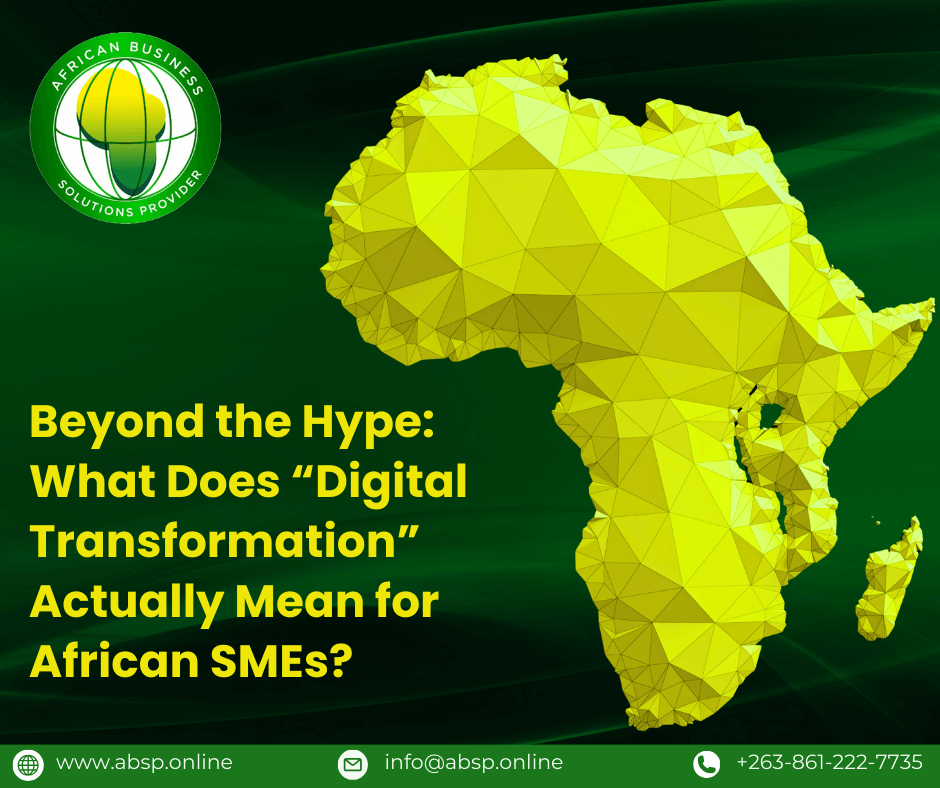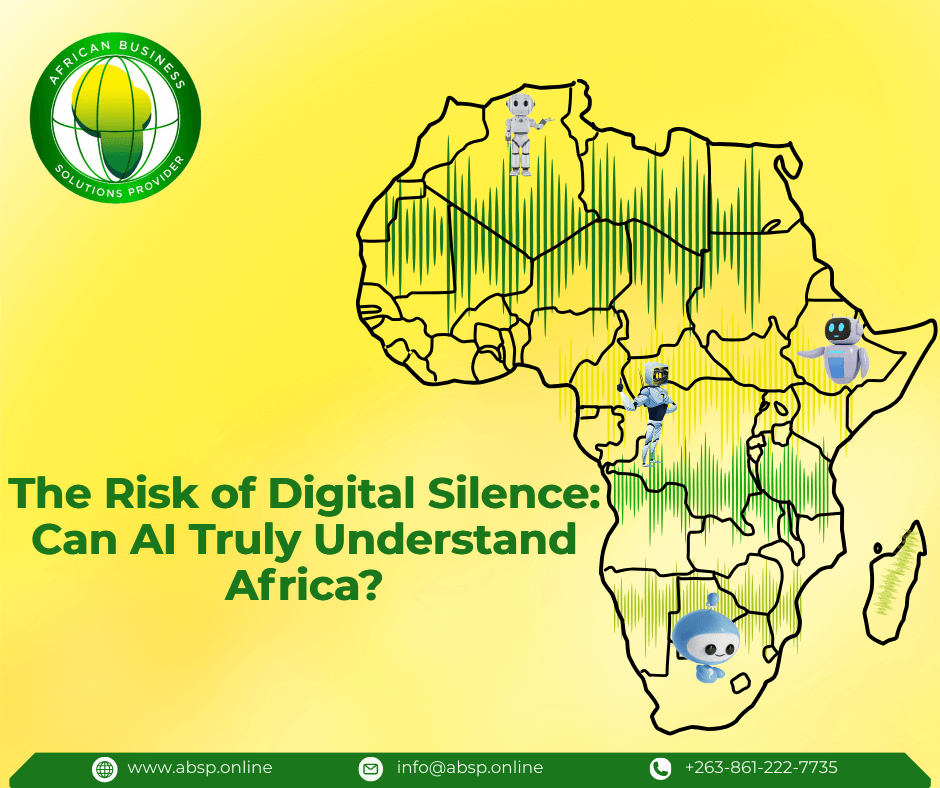Beyond the Hype: What Does “Digital Transformation” Actually Mean for African SMEs?
Introduction
“Digital transformation” is everywhere in business conversations. But for many small and medium enterprises (SMEs) in Africa, it can sound vague, expensive, or out of reach. Is it just buying new gadgets? Upgrading the website? Or something deeper?
For SME owners, digital transformation should mean more than tech trends, it should mean real change: faster operations, more customers, reduced costs, better services. At African Business Solutions Provider (ABSP), we help SMEs move beyond buzzwords to practical steps that deliver value, especially in African contexts where infrastructure, regulation, and cost matter.
1. The State of Digital Transformation in Africa
Growing connectivity, but still gaps. Sub-Saharan Africa has made big strides in internet access. Between 2019-2022, broadband and mobile internet expanded. But many businesses, especially outside cities, still face unreliable internet, weak broadband speed, and high costs.
High motivation among SMEs. Many SMEs see digital tools (payments, e-commerce, social media) as essential. A survey across eight African countries found that using digital payment systems, online platforms, and social media improves reach, efficiency, and competitiveness. But over 30% report lack of skills or finance hold them back.
Rapid market growth. The Africa digital transformation market is accelerating: cloud services, managed IT, AI/ML are growing quickly. Large enterprises lead for now, but SMEs are catching up fast, according to Mordor Intelligence.
2. What “Digital Transformation” Really Means for SMEs
When it comes to real impact, digital transformation for SMEs goes beyond buzzwords and focuses on a few practical areas.
Payments & Sales Channels – Accepting digital payments, setting up an online storefront, and leveraging social media or marketplaces to reach customers.
Operations Efficiency – Using cloud tools to manage inventory, staff, accounting, and scheduling, which reduces manual work and minimizes errors.
Customer Engagement & Marketing – Reaching customers through WhatsApp, SMS, or social media, while using simple feedback or data to improve service.
Data & Insights – Tracking key metrics such as sales trends, customer behavior, and stock levels, with easy dashboards replacing guesswork.
Resilience & Continuity – Ensuring data backups, enabling remote access, and staying connected with customers even during power cuts, disruptions, or lockdowns.
3. Main Barriers African SMEs Face
Understanding what holds people back is critical to making transformation work.
Infrastructure issues – unreliable electricity, slow or expensive internet, lack of data centers.
Cost – both upfront cost (technology, devices, setup) and ongoing costs (internet, maintenance).
Skills – employees (and owners) may lack familiarity with digital tools and how to use them well.
Regulation & Policy – unclear laws around data privacy, cross-border payments, licensing etc. can make SMEs wary.
Fear of change – switching from “the way we’ve always done things” is hard, especially when risk feels high.
4. Affordable & Practical Pathways: ABSP’s Roadmap
Here’s how ABSP helps SMEs translate digital transformation into doable, affordable steps:
Diagnostics & Prioritization
We start by evaluating where the biggest pain points are—payment delays, customer reach, operations inefficiencies—so you focus on what matters most.
Low-cost Starter Tools
Use free or low-cost cloud-based tools (for accounting, communication, scheduling). For example, cloud email, inventory tools, WhatsApp Business integration.
Digital Payments & E-Commerce
Help SMEs integrate reliable payment gateways and set up simple online stores or marketplaces. In South Africa, 90% of SMEs have adopted digital payments, seeing benefits in speed and business credibility.
Training & Capacity Building
ABSP runs hands-on training for staff on how to use tools, interpret simple data dashboards, manage digital marketing, and maintain basic cybersecurity.
Resilience Planning
Ensuring data backups, cloud storage, remote working setups, and business continuity practices in case of disruptions.
Scaling Up Gradually
Once basics work, add more advanced tools: integrate across departments, automate workflows, use CRM or lightweight ERP, and adopt hybrid cloud solutions as needed.
5. Impact & Opportunities for African SMEs
Increased revenue and customer base: Digital channels enable SMEs to reach beyond local markets.
Reduced costs and waste: Less paperwork, fewer errors, fewer lost sales.
Better competitiveness: Customers expect digital presence; digital SMEs are often seen as more credible.
Job creation and skills development: As SMEs digitize, they need people who can manage tech, giving opportunities for skill growth.
Economic growth & inclusion: A strong SME sector digitally enabled can help reduce poverty and improve overall GDP—especially in rural or underserved areas. This is reinforced by World Bank findings that internet access and digital services increase labor participation and wages.
Conclusion
Digital transformation doesn’t have to be overwhelming or expensive. For African SMEs, it’s about picking the right tools, starting simply, and growing steadily. It’s not about having the fanciest tech, it’s about making better, smarter business decisions today.
At ABSP, our mission is to turn digital transformation from a catchphrase into everyday reality for SMEs. We work with you to map, build, train, and scale without breaking the bank.



Comments
John Doe
January 26 2021
Lorem ipsum dolor sit amet, consectetur adipisicing elit. Architecto aspernatur cupiditate dolore laudantium magni maiore minus odit optio perspiciatis qui, rem sit unde? Aliquid dolor, eaque eligendi minus quis sequi?
John Doe
January 26 2021
Lorem ipsum dolor sit amet, consectetur adipisicing elit. Architecto aspernatur cupiditate dolore laudantium magni maiore minus odit optio perspiciatis qui, rem sit unde? Aliquid dolor, eaque eligendi minus quis sequi?